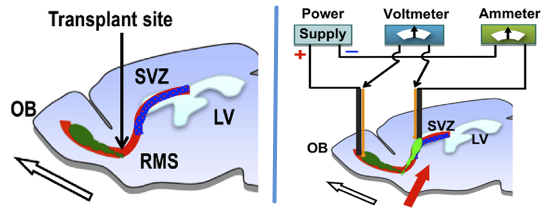The Role of Direct Current Electric Field-Guided Stem Cell Migration in Neural Regeneration April, 2016
Neural stem cells steered by electric fields can repair brain damage
July 17, 2017

Electrical stimulation of the rat brain to move neural stem cells (credit: Jun-Feng Feng et al./ Stem Cell Reports)
Electric fields can be used to guide transplanted human neural stem cells — cells that can develop into various brain tissues — to repair brain damage in specific areas of the brain, scientists at the University of California, Davis have discovered.
It’s well known that electric fields can locally guide wound healing. Damaged tissues generate weak electric fields, and research by UC Davis Professor Min Zhao at the School of Medicine’s Institute for Regenerative Cures has previously shown how these electric fields can attract cells into wounds to heal them.
But the problem is that neural stem cells are naturally only found deep in the brain — in the hippocampus and the subventricular zone. To repair damage to the outer layers of the brain (the cortex), they would have to migrate a significant distance in the much larger human brain.

Migrating neural stem cells with electric fields. (Left) Transplanted human neural stem cells would normally be carried along by the the rostral migration stream (RMS) (red) toward the olfactory bulb (OB) (dark green, migration direction indicated by white arrow). (Right) But electrically guiding migration of the transplanted human neural stem cells reverses the flow toward the subventricular zone (bright green, migration direction indicated by red arrow). (credit: Jun-Feng Feng et al. (adapted by KurzweilAI/ StemCellReports)
Could electric fields be used to help the stem cells migrate that distance? To find out, the researchers placed human neural stem cells in the rostral migration stream (a pathway in the rat brain that carries cells toward the olfactory bulb, which governs the animal’s sense of smell). Cells move easily along this pathway because they are carried by the flow of cerebrospinal fluid, guided by chemical signals.
But by applying an electric field within the rat’s brain, the researchers found they could get the transplanted stem cells to reverse direction and swim “upstream” against the fluid flow. Once arrived, the transplanted stem cells stayed in their new locations weeks or months after treatment, and with indications of differentiation (forming into different types of neural cells).
“Electrical mobilization and guidance of stem cells in the brain provides a potential approach to facilitate stem cell therapies for brain diseases, stroke and injuries,” Zhao concluded.
But it will take future investigation to see if electrical stimulation can mobilize and guide migration of neural stem cells in diseased or injured human brains, the researchers note.
The research was published July 11 in the journal Stem Cell Reports.
Additional authors on the paper are at Ren Ji Hospital, Shanghai Jiao Tong University, and Shanghai Institute of Head Trauma in China and at Aaken Laboratories, Davis. The work was supported by the California Institute for Regenerative Medicine with additional support from NIH, NSF, and Research to Prevent Blindness Inc.
Abstract of Electrical Guidance of Human Stem Cells in the Rat Brain
Limited migration of neural stem cells in adult brain is a roadblock for the use of stem cell therapies to treat brain diseases and injuries. Here, we report a strategy that mobilizes and guides migration of stem cells in the brain in vivo. We developed a safe stimulation paradigm to deliver directional currents in the brain. Tracking cells expressing GFP demonstrated electrical mobilization and guidance of migration of human neural stem cells, even against co-existing intrinsic cues in the rostral migration stream. Transplanted cells were observed at 3 weeks and 4 months after stimulation in areas guided by the stimulation currents, and with indications of differentiation. Electrical stimulation thus may provide a potential approach to facilitate brain stem cell therapies.
This finding is the first time I have gotten excited about stem cell therapy for stroke survivors.
ReplyDelete